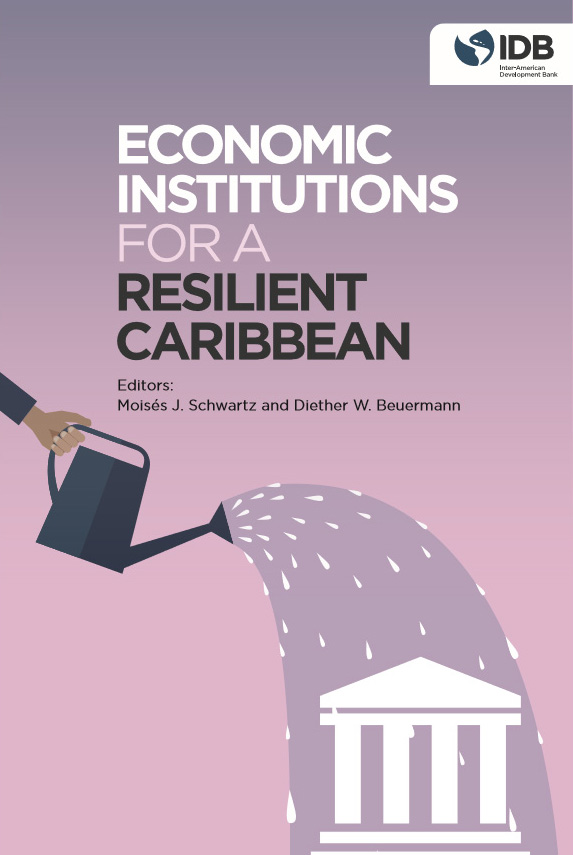Ensuring proper management of Guyana’s projected oil bonanza will likely pose a great challenge given social and political pressures and the country should therefore adopt an expenditure rule, according to a February 2021 Inter-American Development Bank (IDB) study.
Entitled `Economic Institutions for a Resilient Caribbean’, the study said that the history of many oil producers has shown that excessive expenditure in the wake of oil discoveries results in inflationary pressures, future rigidities in the budget, and/or wasteful investment projects, particularly when institutions for management of the budget and public investments are weak.
“To counteract such pressures, Guyana would be well advised to quickly adopt an expenditure rule. This could be done by capping the real rate of growth of primary expenditures of the central government at a level somewhat lower than that of real GDP. The differential could be set higher for the next five years, when GDP growth is projected to accelerate sharply, and reviewed and reduced thereafter as GDP growth decelerates to its longer-term average”, the report said.
Despite having been in oil production since December 2019, an expenditure rule has not been adopted as the Natural Resource Fund (NRF) Act has not been activated. The NRF is Guyana’s version of a Sovereign Wealth Fund. The NRF was not activated as the then opposition PPP/C had refused to participate in its various committees in 2019. Since entering office in August 2020, the PPP/C government has neither activated the NRF nor brought new legislation. Critics have said that it is doing exactly what the IDB Report recommends against – unrestrained spending on the basis of projected earnings.
The 2021 budget presented in February by Minister with responsibility for Finance, Dr Ashni Singh made no pronouncement on the fate of the NRF neither did it recognise an expenditure rule. Further, the budget revealed the biggest deficit the country has so far seen on top of a huge one in the 2020 budget.
The IDB study said that to ensure that an adequate share of the additional spending goes to public investments, a ceiling could also be established on the ratio of current to total primary spending.
“This should be accompanied by a deliberate effort to ensure that the main weaknesses in the public investment management system … are corrected in the near term, and that Guyana’s scores on the IMF’s public investment management assessment rise to at least the average level of comparator countries, which they now lag by a significant margin in most areas. Such a sub-ceiling should also be accompanied by a strengthening of accounting regulations to avoid misclassifications of current spending as investment”, the study said.
The IDB study asserted that the expenditure rule should be attended by the adoption of a “target path for public debt through the next decade, consistent with the elimination of the primary deficit over the next two to three years and growing surpluses thereafter”.
It added that the debt could be specified as net of assets accumulated in the Natural Resource Fund if the “current rigid and complicated rules for deposits into and withdrawals from that fund were made flexible. This would facilitate appropriate asset-liability management”.
The IDB study has mistakenly said that there is an NRF in operation. There is legislation on the books but the NRF is not functioning. Moreover, oil revenues accrued to the country are presently lodged at the New York Federal Reserve Bank and are not formally within the ambit of the NRF.
Swiftly
The IDB study said that the government should also swiftly implement its intention, as stated in the Green State Development Strategy to develop a medium term fiscal framework (MTFF). It said that a rolling MTFF, consistent with the expenditure rule, would enable assessment of the prospects of achieving the target debt path under prudent and relevant macroeconomic, external, and policy assumptions.
“The robustness of these assumptions should be tested through appropriate sensitivity and scenario analysis. The reasons for year-to-year changes in the MTFF should be explained in the corresponding budget documents, as should be deviations of the fiscal balance outturn from its budgeted level. The government should be required to put forward specific proposals for corrections of those deviations if they exceed a reasonable threshold, within a time horizon of one to two years”, the IDB study recommended.
It added: “The MTFF should be transparently presented and discussed in the annual budget document, and it would benefit from the review and comments of an independent fiscal council. It should be complemented by a detailed analysis of the finances of (State Owned Enterprises) SOEs, both individually and on a consolidated basis, which would require significant strengthening of the current systems of monitoring and reporting SOE operations. It would also be important to develop a system of limits for SOE borrowing based on indicators of their debt servicing capacity and liquidity”.
The study warned about the volatility of oil proceeds and the concomitant difficulty of orchestrating fiscal policy.
“Oil revenues—which will be uncertain, volatile, and relatively shortlived, and which could lead to strong spending pressures—will add to the difficulties of conducting fiscal policy. The government will need to foster macroeconomic stability, ensure fiscal sustainability, aim for an equitable intertemporal distribution of oil wealth, and meet developmental objectives considering its institutional capacity. The time-bound nature of the resources puts a premium on their good use.
“The looming start of significant oil production makes the establishment of sound fiscal institutions adapted to that new reality a top priority. In this regard, it is essential that Guyana put in place a macroeconomic and fiscal framework …In particular, there is no published medium-term fiscal framework. Although the budget document for 2019 includes indicative budgets for the following three years, fiscal policy is not guided by formal medium-term objectives. Budget formulation focuses on annual budgets. The government’s development plan document indicates that budget operations must transition to a medium-term expenditure framework”, the study stated.
The report emphasized that the NRF is an important first step to channel Guyana’s resources for savings and investment.
“This exercise has served as an example showing that the absence of a constraint or a fiscal rule on the annual budget process could lead to increased spending on the back of savings in the NRF, leading to higher debt-financed budget deficits that could erode the savings in the NRF. Given the size of the expected increases in income and the associated wealth effect due to the government’s increased spending capacity, Guyana would be well served to broaden its fiscal framework by adopting a fiscal rule …”
The IDB study also sounded a warning over the perceived lack of institutional capacity.
“The NRF complemented with a fiscal rule would contribute to strengthening Guyana’s fiscal framework. However, the intended outcomes of these policies could be undermined by the government’s institutional capacity to implement policies. In 2018, Guyana ranked in the 42nd percentile of the World Governance Indicators on its measure of government effectiveness, below the Latin American and Caribbean average of 44 percent and the average for the countries in the IDB’s Caribbean Country Department (CCB) of 56 percent, suggesting a relatively weak standing. Recall that the modeling in this exercise indicates that the government would have to absorb between US$300 million and US$500 million in the medium term and more in the long term, while the government currently has a budget of approximately US$1.6 billion. The impending oil boom will potentially put pressure on the government’s public financial management system and challenge the government’s absorptive capacity to spend productively. The literature suggests that if windfall income stimulates wasteful spending or causes a breakdown in governance, these negative effects could be welfare-reducing (Collier et al. 2010)”, the study argued.









